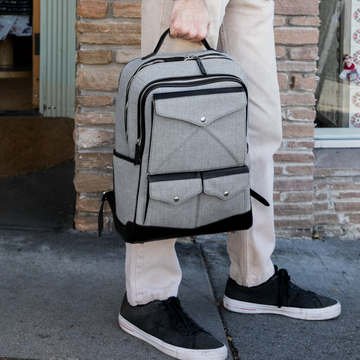The market for sustainable bags is estimated to grow at a higher rate in the next few years. More and more brands are adopting custom-printed bags. With the popularity of sustainable and eco-friendly bags, printing on handbags has also become popular. However, the essential thing to consider is the printing method used to print on these handbags. Some of the most common ways include- screen printing, heat transfer, sublimation, flocking, and many more. However, the type of bag you choose depends on the handbag requirements. This blog will discuss what kind of printing is used for sustainable bags and how to select the proper printing.
Types Of Printing Used for Sustainable Bags:
If you want to do printing on canvas tote bags, then below are the various printing options mentioned.
1. Screen printing-
Screen printing, also known as silk printing, uses printing made from nylon mesh and steel frame. These printing screens are like a template through which paint is pressed for application. The colours are applied one by one on different screens. The patterns are transferred onto the fabric in layers.
Screen printing is among the most uncomplicated printing methods, which means its application is limited. It allows you to use up to six colours of your designs in theory, but in actual production, this method is not approved for multi-colour prints. You can only use screen printing with less than three colours. Some of the various types of screen printing available include-
- Rotary screen printing- used for ready-made tote bags
- Flat screen printing- used to print on rolls of fabric
- Hand screen printing- used for hand-made printing
Screen printing is most effective for simple prints like logos and letters. It is impossible to print an excellent photographic image with it. This type of printing goes well with simple geometric patterns and shapes. In simple terms, screen printing is effective for bulk printing sober patterns. The best example is to print small polka dot patterns on fabric.
2. Heat transfer-
It uses pressure and heat to put designs on customized eco bags. Heat-applied material with a sticky side is used for this method. The gummy is activated when heat is applied through an iron which makes the material stick to the handbag. It can also be done with heat transfer paper and printer. There are mainly two types of heat transfer techniques-
- Digital heat transfer
- Vinyl heat transfer
It is feasible to transfer highly realistic photo images to bags. However, heat transfer printing can only be used on fabric that can handle heat. The method cannot be used for synthetic materials.
3. Sublimation-
Sublimation printing is much similar to heat transfer printing with minor differences. In this method, the printed designs are transferred on sublimation paper. Likewise, to heat transfer, this method also uses heat and pressure to turn solid ink into gaseous form. When the ink cools, it turns into a solid state and sticks to the fabric.
However, sublimation can only be used with limited fabrics; it mainly works on polyester fabrics only. Handbags made with 100% cotton cannot hold the sublimation ink. Another limitation of sublimation printing is that the material needs to be white or light-coloured.
4. Gravure painting-
The painting, also known as rotogravure painting, creates laminated canvas bags. The process is divided into two parts; in the first step, the design is printed on a film. In the second step, the printed film is laminated on the fabric. It develops a seamless print, and the whole process is done with the help of machines. The gravure painting is known for producing highly durable and waterproof prints. The printing film comes in two forms, matte and bright, with one variation.
Gravure printing is good for bulk production and high-amount projects. For such projects, it minimizes the cost and time. However, the material and starting costs are high, which is unsuitable for small projects. This painting type is mainly used for canvas bags where large areas must be covered with colour.
5. DTG (direct to garment) printing-
DTG printing uses digital technology to develop high-quality prints. It uses similar technology to inkjet printers. The nozzle of the printer sprayed ink on the material. This ink then dissolves and merges into the fabric. This sustainable print results in a convenient handbag. The manufacturing process of DTG is relatively short compared to the other printing methods.
Direct garment printing allows you to work with various colour choices, and it is suitable for printing pictures and realistic images. Printing does not work with transparency; hence, it must be completely opaque. DTG printing is eco-friendly and sustainable as it creates less waste.
6. Machine embroidery-
Other than printing, many handbags are also embroidered. Though hand embroidery is a good option, machine embroidery is much easier. You can put the design in it and let the machine do the rest of the job. The process needs an embroidery digitizer in which a printer embroidery designs.
If you want your tote bag to have custom embroidery, you can go for the hand-embroidery option. The process is completely automated and non-labour-demanding.
7. Flocking-
The flock print uses cotton or synthetic materials to create an engraved effect. These fibres are transferred in a holding to which they stick and make a lifted layer. The short materials leave a soft surface on the print, and it can be easily dyed in different colours. Flock printing can have an excellent effect if you have a tote bag.
Final Thoughts:
The above blog talks about different printing techniques and how they work on different fabrics. In the case of sustainable handbags, you need to choose the proper printing technique depending on whether you have a tote bag or any other type of handbag. Also, consider which printing process is eco-friendly and creates less harm to the environment. I hope the blog proves helpful to you.
Read How Vegan Fashion Is A Key To Vegan Lifestyle?







